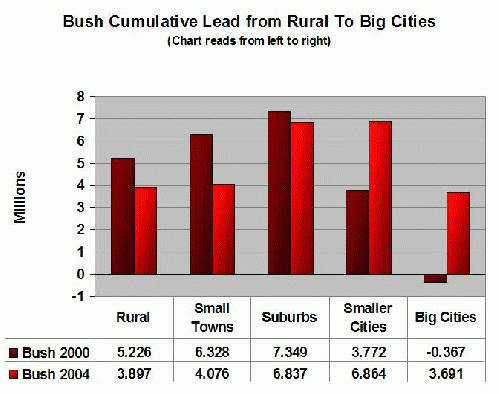In addition, big city voters must have been “motivated” by something. Compared to 2000, rural turnout was down 2.0 million, small towns up sharply at 88% (yet still a small segment), and suburban turnout up slightly, with the smaller cities showing a modest increase which was still less than the reported national average. Turnout in cities over 500 thousand in population increased by 66%. What was this all about? The answer to that question and the plausibility of the answer to that question is vital in understanding the story we were told of the 2004 election results.
FIGURE 3. We are expected to believe that after doing poorly in the rural area and small towns, Bush attracted several million new big city voters and pulled off a last minute victory. In the small towns he was well below his 2000 performance for total votes. In the “red” zone, rural America, he got fewer votes in 2004 than he did in 2000 while turnout was up across the nation.
Bush didn’t win the cities. He didn’t have to, he was already winning. Ultimately he had to achieve a better split in the big cities than he had in 2000. Looking at the chart above, you see the increase in Bush votes in the five location categories.
According to the vote totals, the real kill shot for the Bush victory came from large urban areas, “big cities”, defined as those with a population of half a million or more, e.g., New York, Chicago, Detroit, etc. These cities had been the strongest base for Democrats since the Great Depression. There had been variations in turnout from presidential election to election, but the margins had always remained strong.
The Bush Urban Wave of 2004 by the Numbers
The most instructive way to look at the remarkable and certainly unpredictable Bush urban wave is to take his cumulative margin starting with the rural areas and moving to progressively more dense population areas ending up with the big cities.
Bush started out with a 5.0 million vote margin in rural America in 2000 when 105 million votes were cast. With 122 million cast in 2004, his core constituency gave him only a 3.9 million margin by comparison. There were 23.8 million votes cast in the rural segment in 2000 and just under 20 million in 2004. In fact, given the very high rural turnout rates from 2000, it would have been unlikely that the total margin could increase in 2004.
Towns with a population or 10 to 50 thousand accounted for 5.0 million votes in 2000 with Bush taking this group 60 - 40% over Gore. Votes totals reached nearly 10 million and there was a 48% Kerry - 50% Bush split. These added just 175 thousand votes to the accumulated margin for Bush. In 2000, Bush added 1.1 million votes to his margin for this segment.
At this point things were looking grim for George W. Bush. His rural base stayed home and small town voters nearly doubled their 2000 vote totals and split even. After these Republican core area totals, he was up by 4 million votes. In 2000, at this juncture, he had been up 6.3 million votes with a smaller electorate.
The suburbs, the largest voting block, showed slight improvement for Bush. He increased his 2000 victory margin there from two to five percent and the suburban share went from 43% to 45%. Yet his cumulative margin at this juncture was 6.8 million compared to 7.3 million in 2000 and there were many more Americans yet to vote.
Figure 4. Graph reads from left to right, e.g., 2004 3.8 million rural lead in rural areas; adding the small town margin, Bush has only 4.0 million cumulative - net lead when 2004 small town votes are factored in. This shows that Bush “won”, not by building up a huge lead that was eroded in urban areas, but by building up a much smaller lead that was not nearly as dramatically “eroded” in the cities.
Gore had fared worse than Kerry by a long shot in Rural and Small Town America but then broke even in the suburbs. Once he hit the smaller and big cities, Gore was on a roll and pulled out the forgotten half million popular vote victory.
In 2004, Bush struggled in the rural and small town segments. He gained a modest advantage in the suburbs. Things weren’t looking good compared to his 2000 performance.
Then the urban wave began to form. According to the final exit poll, despite being abandoned by his 2000 base, which was specifically targeted for even more votes in 2004, Bush rallied in the smaller cities. He went from a loss of 60%-40% in 2000 to a dubious break even in 2004. Instead of an inadequate 3.8 million advantage in 2000, Bush went downtown, so to speak, with a seemingly staggering 6.8 million vote advantage over Kerry.
Next Page 1 | 2 | 3 | 4 | 5 | 6 | 7 | 8 | 9 | 10 | 11
(Note: You can view every article as one long page if you sign up as an Advocate Member, or higher).






